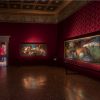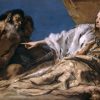This chamber housed the Magistratura dei Conservatori ed esecutori delle leggi e ordini degli uffici di San Marco e di Rialto, to give them their full title. Created in 1553, this authority was headed by three of the city’s patricians and was responsible for making sure the regulations concerning the practice of law were observed.
In a mercantile city such as Venice, the courts were of enormous importance (think, for example, of the amount of litigation, the number of court-cases, which must have arisen within such a huge market as the Rialto). And the administration of justice in the city was made all the more special by the fact that it was not based on Imperial, Common or Roman law but on a legal system that was peculiar to Venice.
WORKS ON DISPLAY:
Giambattista Tiepolo (1696-1770)
Neptune Offering the Riches of the Sea to Venice, 1756-1758
Oil on canvas
Venice is depicted lying like a beautiful queen; she wears the doge’s cloak and leans on the lion, symbol of the Serenissima. With her hand she indicates the god of the sea Neptune who pours a cornucopia full of gifts onto her feet: corals and pearls represent the dominions of the Republic; gold coins and jewels instead refer to the wealth generated by trade. The image perfectly restores the myth of Venice that its ruling class intended to perpetuate, despite the objective political and military weakness that the State was
experiencing in the decades preceding its fall in 1797.
The painting was created by Giambattista Tiepolo to replace the one of a similar subject previously painted by Jacopo Tintoretto for a section of the ceiling of the Sala delle Quattro Porte of the Doge’s Palace. In those years, when Titian was already strongly interested in the revival of sixteenth-century Venetian painting, this commission gave him the opportunity to immerse himself even more in this tradition, looking in particular at the works created by Paolo Veronese for the rooms of the Palazzo Ducale.

